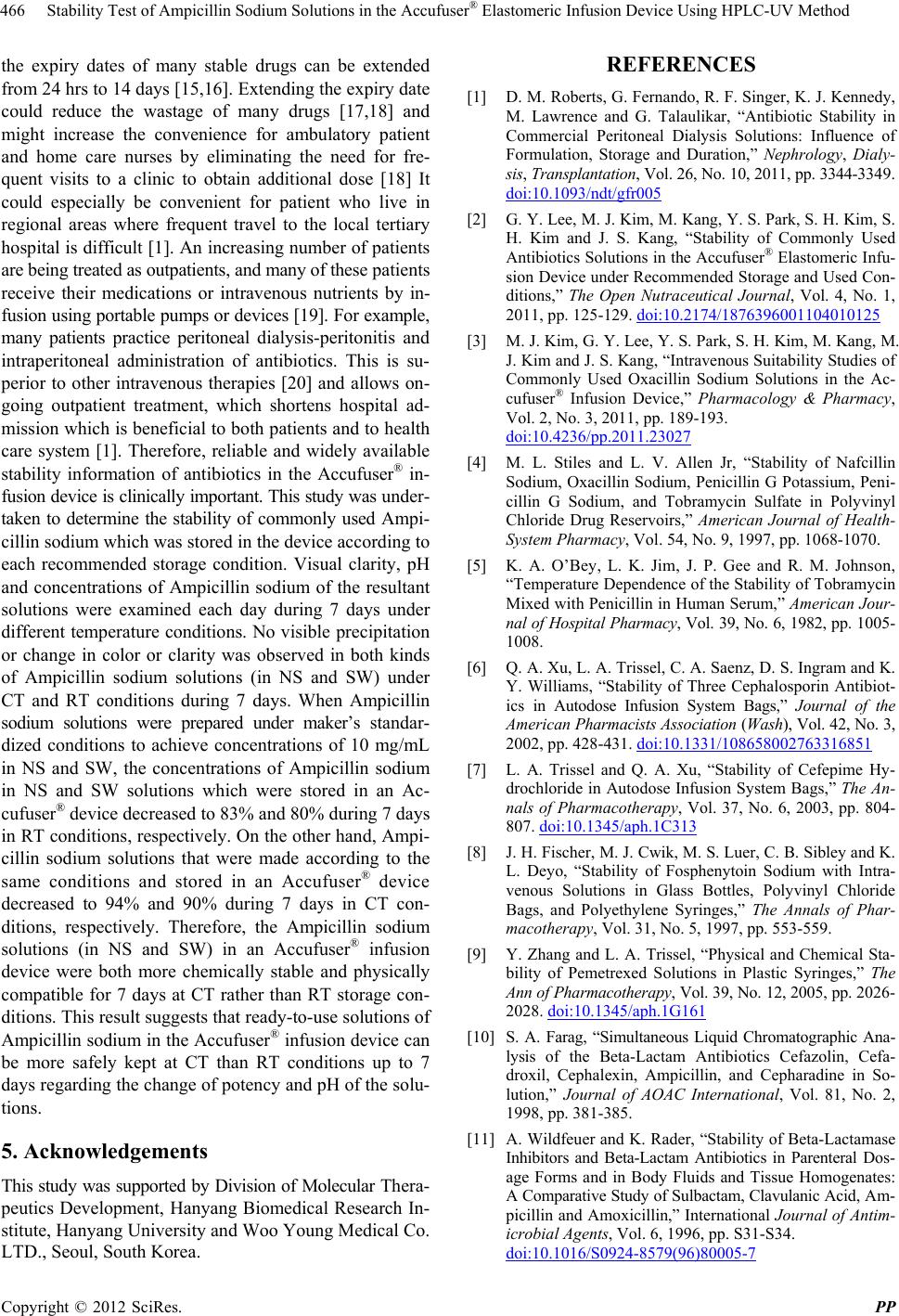
Stability Test of Ampicillin Sodium Solutions in the Accufuser® Elastomeric Infusion Device Using HPLC-UV Method
466
the expiry dates of many stable drugs can be extended
from 24 hrs to 14 days [15,16]. Extending the expiry date
could reduce the wastage of many drugs [17,18] and
might increase the convenience for ambulatory patient
and home care nurses by eliminating the need for fre-
quent visits to a clinic to obtain additional dose [18] It
could especially be convenient for patient who live in
regional areas where frequent travel to the local tertiary
hospital is difficult [1]. An increasing number of patients
are being treated as outpatients, and m a ny of these patients
receive their medications or intravenous nutrients by in-
fusion using portable pumps or devices [19]. For example,
many patients practice peritoneal dialysis-peritonitis and
intraperitoneal administration of antibiotics. This is su-
perior to other intravenous therapies [20] and allows on-
going outpatient treatment, which shortens hospital ad-
mission which is beneficial to both patients and to health
care system [1]. Therefore, reliable and widely available
stability information of antibiotics in the Accufuser® in-
fusion device is clinically important. This study was un de r-
taken to determine the stability of commonly used Ampi-
cillin sodium which was stored in the device according to
each recommended storage condition. Visual clarity, pH
and concentrations of Ampicillin sodium of the resultant
solutions were examined each day during 7 days under
different temperature conditions. No visible precipitation
or change in color or clarity was observed in both kinds
of Ampicillin sodium solutions (in NS and SW) under
CT and RT conditions during 7 days. When Ampicillin
sodium solutions were prepared under maker’s standar-
dized conditions to achieve concentrations of 10 mg/mL
in NS and SW, the concentrations of Ampicillin sodium
in NS and SW solutions which were stored in an Ac-
cufuser® device decreased to 83% and 80% during 7 days
in RT conditions, resp ectively. On the other hand, Ampi-
cillin sodium solutions that were made according to the
same conditions and stored in an Accufuser® device
decreased to 94% and 90% during 7 days in CT con-
ditions, respectively. Therefore, the Ampicillin sodium
solutions (in NS and SW) in an Accufuser® infusion
device were both more chemically stable and physically
compatible for 7 days at CT rather than RT storage con-
ditions. This result sugg ests that ready-to-u se solutio ns of
Ampicillin sodium in the Accufuser ® infusion device can
be more safely kept at CT than RT conditions up to 7
days regarding the change of potency and pH of the solu-
tions.
5. Acknowledgements
This study was supported by Division of Molecular T her a-
peutics Development, Hanyang Biomedical Research In-
stitute, Hanyang University and Woo Young Medical Co.
LTD., Seoul, South Korea.
REFERENCES
[1] D. M. Roberts, G. Fernando, R. F. Singer, K. J. Kennedy,
M. Lawrence and G. Talaulikar, “Antibiotic Stability in
Commercial Peritoneal Dialysis Solutions: Influence of
Formulation, Storage and Duration,” Nephrology, Dialy-
sis, Transplantation, Vol. 26, No. 10, 2011, pp. 3344-3349.
doi:10.1093/ndt/gfr005
[2] G. Y. Lee, M. J. Kim, M. Kang, Y. S. Park, S. H. Kim, S.
H. Kim and J. S. Kang, “Stability of Commonly Used
Antibiotics Solutions in the Accufuser® Elastomeric Infu-
sion Device under Recommended Storage and Used Con-
ditions,” The Open Nutraceutical Journal, Vol. 4, No. 1,
2011, pp. 125-129. doi:10.2174/1876396001104010125
[3] M. J. Kim, G. Y. Lee, Y. S. Park, S. H. Kim, M. Kang, M.
J. Kim and J. S. Kang, “Intravenous Suitability Studies of
Commonly Used Oxacillin Sodium Solutions in the Ac-
cufuser® Infusion Device,” Pharmacology & Pharmacy,
Vol. 2, No. 3, 2011, pp. 189-193.
doi:10.4236/pp.2011.23027
[4] M. L. Stiles and L. V. Allen Jr, “Stability of Nafcillin
Sodium, Oxacillin Sodium, Penicillin G Potassium, Peni-
cillin G Sodium, and Tobramycin Sulfate in Polyvinyl
Chloride Drug Reservoirs,” American Journal of Health-
System Pharmacy, Vol. 54, No. 9, 1997, pp. 1068-1070.
[5] K. A. O’Bey, L. K. Jim, J. P. Gee and R. M. Johnson,
“Temperature Dependence of the Stability of Tobramycin
Mixed with Penicillin in Human Serum,” American Jour-
nal of Hospital P harmacy, Vol. 39, No. 6, 1982, pp. 1005-
1008.
[6] Q. A. Xu, L. A. Trissel, C. A. Saenz, D. S. Ingram and K.
Y. Williams, “Stability of Three Cephalosporin Antibiot-
ics in Autodose Infusion System Bags,” Journal of the
Ame r ic an Pharmacists Association (Wash), Vol. 42, No. 3,
2002, pp. 428-431. doi:10.1331/108658002763316851
[7] L. A. Trissel and Q. A. Xu, “Stability of Cefepime Hy-
drochloride in Autodose Infusion System Bags,” The An-
nals of Pharmacotherapy, Vol. 37, No. 6, 2003, pp. 804-
807. doi:10.1345/aph.1C313
[8] J. H. Fischer, M. J. Cwik, M. S. Luer, C. B. Sibley and K.
L. Deyo, “Stability of Fosphenytoin Sodium with Intra-
venous Solutions in Glass Bottles, Polyvinyl Chloride
Bags, and Polyethylene Syringes,” The Annals of Phar-
macotherapy, Vol. 31, No. 5, 1997, pp. 553-559.
[9] Y. Zhang and L. A. Trissel, “Physical and Chemical Sta-
bility of Pemetrexed Solutions in Plastic Syringes,” The
Ann of Pharmacotherapy, Vol. 39, No. 12, 2005, pp. 2026-
2028. doi:10.1345/aph.1G161
[10] S. A. Farag, “Simultaneous Liquid Chromatographic Ana-
lysis of the Beta-Lactam Antibiotics Cefazolin, Cefa-
droxil, Cephalexin, Ampicillin, and Cepharadine in So-
lution,” Journal of AOAC International, Vol. 81, No. 2,
1998, pp. 381-385.
[11] A. Wildfeuer and K. Rader, “Stability of Beta-Lactamase
Inhibitors and Beta-Lactam Antibiotics in Parenteral Dos-
age Forms and in Body Fluids and Tissue Homogenates:
A Comparative Study of Sulbactam, Clavulanic Acid, Am -
picillin and Amoxicillin,” International Journal of Antim-
icrobial Agents, Vol. 6, 1996, pp. S31-S34.
doi:10.1016/S0924-8579(96)80005-7
Copyright © 2012 SciRes. PP